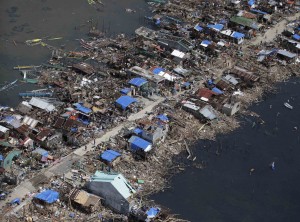Typhoon Haiyan cut through the Philippines on Nov. 8, leaving an estimated 10,000 people dead and inflicting damage to buildings and roads that has affected over 9 million people, according to the Associated Press.

Haiyan devastated the city of Tacloban, leaving it in complete ruins. The Associated Press reported “Tacloban resembled a garbage dump from the air, punctuated only by a few concrete buildings that remained standing.” Typhoon Haiyan’s strength was three times that of Hurricane Katrina.
Typhoons and tropical storms hit the Philippines every year, but it was difficult to prepare for the powerful wreckage of Typhoon Haiyan. Roughly 800,000 people were taken to evacuation centers like schools and churches just hours before the typhoon entered the Phillipines, according to an AP report.
“I don’t think anybody anticipated this storm,” said Dita de Keyser, a BYU Cougarwear employee from Manilla, the capital of the Philippines.
Keyser lived with her family in Manilla, which is 700 kilometers from the path of Haiyan, as a child until she moved away 40 years ago. She endured many tropical storms every year, but said Haiyan (known locally as Yolanda) was an “unprecedented” storm.
“I’ve never had this kind of a storm while we were there — it’s just heartbreaking,” Keyser said. Her family and friends mostly live in Manilla, which was spared from the brunt of the storm.
Relief funds and campaigns to assist those affected by Haiyan have already started. The Church has already began its relief efforts, as more than 14,000 displaced people have sought refuge in 200 meetinghouses.
Despite major damages that inhibit communications in certain areas, LDS Church officials announced that as of Monday morning, all missionaries have been contacted except 24 missionaries serving in one area with very little communication.
All missionaries contacted are safe and in good condition, the Church announced. Church representatives are doing everything possible to contact missionaries and have been providing updates to family members of missionaries regarding their status as soon as they become available, according to Mormon Newsroom.
Several returned missionaries at BYU have started their own campaigns to assist the people with whom they once served. Matt Cowley, a senior studying finance who returned from the Philippines Tacloban mission two years ago, helped start the Typhoon Yolanda Relief Fund.
“A group of us returned missionaries wanted to do something more than just send our prayers,” Cowley said. The Typhoon Yolanda Relief fund goes directly to the LDS humanitarian effort, where 100 percent of proceeds go toward the humanitarian effort. “In two days, we have already raised almost $2,000,” Cowley added.
Two officials estimated the death toll at 10,000 on Nov. 10, but the official count remains well below that figure. According to an AP report, the Philippine military confirmed 942 deaths on Nov. 11, with the final count expected to be days away.




